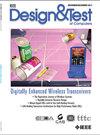Guest Editors' Introduction: Special Issue on Variability and Aging
引用次数: 0
Abstract
The articles in this special section focus on new technological innovationsin EDA design. The constant evolution of electronic systems has been fueled by the continuous and tremendous progress of silicon technology manufacturing. Since 1960, when the first MOS transistor was manufactured with dimensions around 50 cm, process technology has been constantly enhancing until the current 22-nm MOS technology. Every two years a new process generation roughly doubles the device density, following what is known as Moore's law. Besides, every new generation offers faster devices that consume less energy by operation. This has put in the hands of architects more powerful and energy-efficient building blocks on top of which they have designed more effective architectures with increasing capabilities. Silicon MOSFETs have been the workhorse devices for information technologies during all these last decades. However, these technology advances have to deal with important challenges coming from physical limitations of the underlying transistors, which are affected by severe manufacturing process parameters variability and aging caused by electrical degradation of materials due to the intense electrical stress during operation.特邀编辑导言:变异与衰老特刊
这个特别部分的文章关注EDA设计中的新技术创新。硅技术制造的持续巨大进步推动了电子系统的不断发展。自1960年第一个尺寸约为50厘米的MOS晶体管制造以来,工艺技术不断提高,直到目前的22纳米MOS技术。根据摩尔定律,每隔两年,新一代工艺就会使器件密度增加一倍左右。此外,每一代新产品都提供了运行速度更快、能耗更低的设备。这使得架构师可以在更强大、更节能的构建块的基础上设计出更有效、功能更强的架构。在过去的几十年里,硅mosfet一直是信息技术的主力器件。然而,这些技术进步必须应对来自底层晶体管的物理限制的重要挑战,这些限制受到严重的制造工艺参数可变性和由于操作过程中强烈的电应力引起的材料电降解引起的老化的影响。
本文章由计算机程序翻译,如有差异,请以英文原文为准。
求助全文
约1分钟内获得全文
求助全文

 求助内容:
求助内容: 应助结果提醒方式:
应助结果提醒方式:


